The Best Natural Green Food Coloring, According to Our Tests
You're in luck: These plant-based colorings do a nifty job of turning your food green—just in time for St. Patrick's Day.
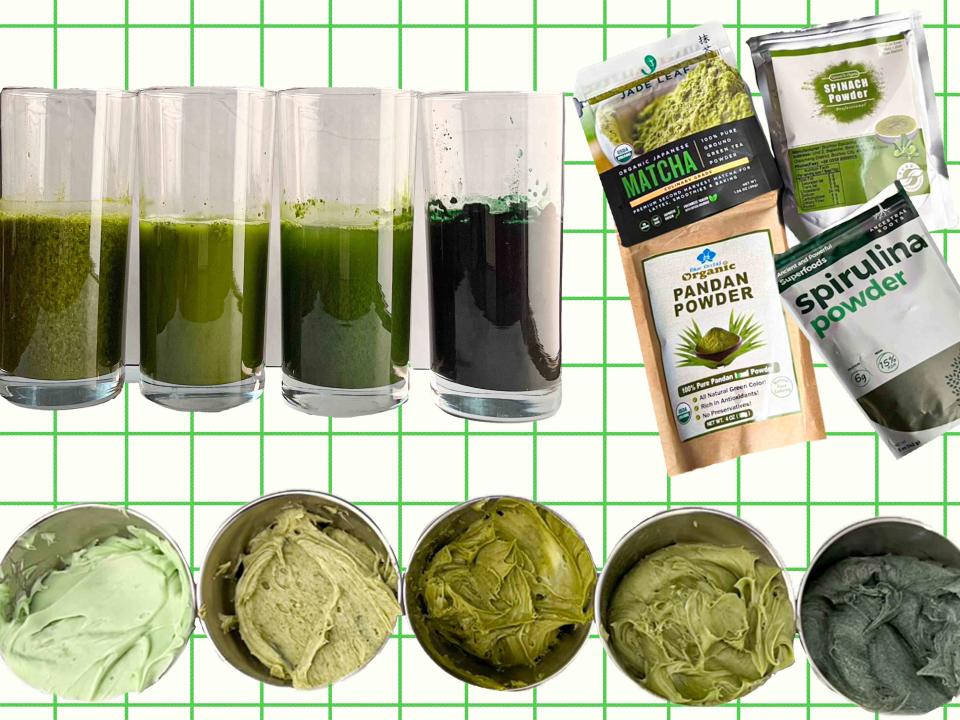
Serious Eats / Kelli Solomon, Amanda Suarez
It's that time of year when the Shamrock Shake briefly graces the menu at McDonald's, announcing to the world that St. Patrick's Day is just around the corner. Whether you celebrate the holiday or not, many of us will find ourselves awash in green: clothing, beer, and especially food. I, for one, love to get festive with my food, especially when that means adding bright colors. Of course one way to add green is with a bottle of food coloring, but I was curious to see whether I could turn various foods green without a dropper of food dye.
While studies aren't conclusive about the health effects of synthetic food dyes, there are enough lingering questions to justify seeking a plant-based alternative. Plus, I really love to play with my food. (Full disclosure: Years ago, I jumped headfirst into the green juice trend, so I'm no stranger to playing around with pulverized green plants. I admit it is an acquired taste.) So if you're wondering whether you can create the same brilliant greens you’d get from a bottle of food coloring with plant-based alternatives, look no further. I tested several options, so you don't have to.
My Color Mixing Methodology
For this experiment, I searched online for “natural green food coloring” to find some of the most popular options, then selected four plant-based powders to test. For my first test, I mixed up solutions of 100ml water and one teaspoon of green powder and filled small glass bottles to the brim to observe their color diluted in water. Then I made our copycat Shamrock Shake, substituting the green food coloring for one teaspoon of each plant-based powder per cup of milkshake. I also got a few standard containers of white cake frosting from the supermarket and stirred a teaspoon of each green product into 100g frosting. For each application, I rated the powder’s detectability, flavor impact, and color. To identify the nuanced shades of green, I reference green swatches from the company that introduced me to the subtleties of color—Crayola.
So, What Makes These Foods Green?
While the typical food coloring relies on synthetic dyes like FD&C Green No. 3 (Fast Green) or a combination of FD&C Blue No. 1 (Brilliant Blue) and FD&C Yellow No. 5 (Tartrazine) the green pigments in plants and algae primarily come from chlorophyll. In addition to chlorophyll, the blue “accessory pigment” phycocyanin is also present in some algae; it aids chlorophyll in photosynthesis and contributes to the deep green color.
If you use plant-based food coloring in your food, please note that while the color can be vibrant initially, it tends to fade faster than foods colored with synthetic food coloring. One reason that happens is that chlorophyll eventually breaks down, especially if you expose it to heat—for example, if you put it in cupcake batter before baking to turn them green. For that reason we avoided any tests involving heat. Even without heat, many natural greens will slowly start to lose their vibrancy once exposed to oxygen so don’t be surprised if they appear a little faded after sitting overnight. But so do flowers, right? Additionally, baking is a science, so the impact of adding these powders to any given recipe could be dramatic and hard to predict.
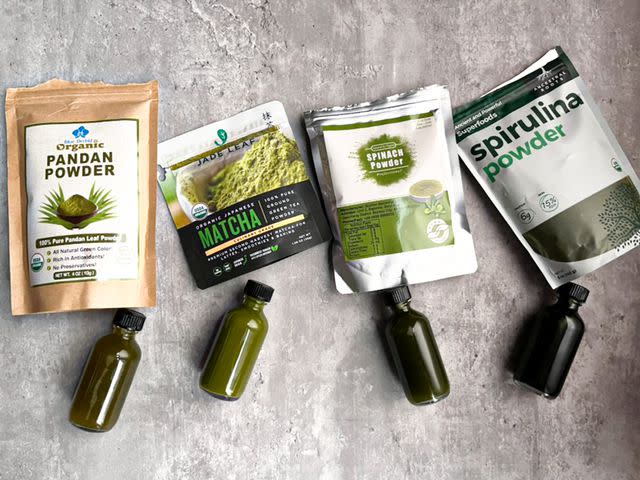
Serious Eats / Kelli Solomon
Green #1: Pandan Powder
Up first was pandan (pandanus amaryllifolius), a shrub found in tropical areas of Southeast Asia. It’s used fresh, dried, or as an extract, and is used to add a pretty color and alluring aroma to desserts like rice pudding, buko pandan, and this pandan cake, as well as in savory dishes like the Malaysian rice dish nasi lemak.
Pandan Powder Water Test: When I mixed the pandan powder into water, the color of the solution was a dull grassy green with hints of yellow—closest to Pea Green on the Crayola chart. The solution wasn't homogenous; the color separated quickly with tiny fibers settling at the bottom.
Pandan Powder Shamrock Shake Test: The milkshake was only the faintest green, but the flavor of the pandan paired nicely with the mint and creaminess of the milkshake.
Pandan Powder Frosting Test: The frosting had a richer color, but it wasn't homogenous and a little too vegetal for my palate.
Pandan Powder Conclusion: While pandan might not be the perfect dye if you are going for a vibrant green result, the flavor is a different story. Many compare pandan to vanilla, which makes sense in that they both have floral qualities and pair well with sugar, but pandan's sweet-smelling, grassy aroma is truly unlike anything else. I will certainly use pandan the next time I bake a cake or make some ice cream.
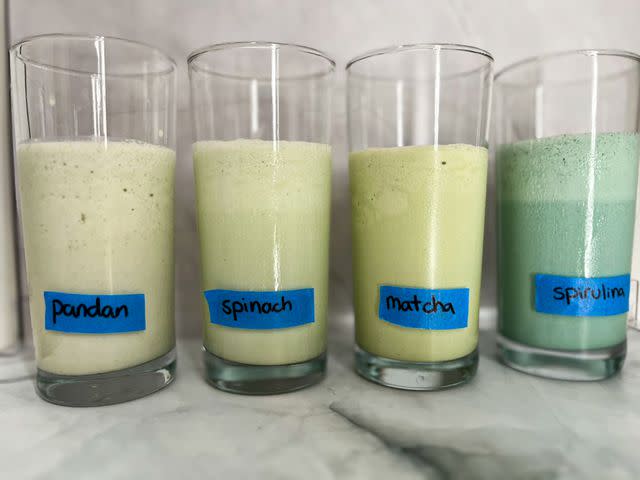
Serious Eats / Kelli Solomon
Green #2: Matcha
Matcha is a ground tea powder made from tea plants (camellia sinensis) shaded from direct sunlight. Matcha is traditionally served as a hot drink, but iced matcha is also delightful, and the powder can be used as a flavoring in numerous desserts, like ice cream.The matcha I selected was culinary-grade, designated for cooking or making lattes and smoothies.
Matcha Water Test: The water solution was very opaque with a color closest to Crayola’s Grass Green. It had a very vegetal, slightly floral smell. It had an earthy vibe, sharp at first, and a smoother finish.
Matcha Shamrock Shake Test:The matcha was more visible than the pandan in the milkshake but still faint; the flavor was mellow, more of an aftertaste, and less noticeable than the mint.
Matcha Frosting Test: The color was more robust in the frosting, and the sugar toned down the sharpness of the tea.
Matcha Conclusion: Matcha certainly won't provide you with the brightest green color, but it's an iconic dessert flavor for a reason. Give it a try the next time you're craving some cookies, or combine it with white chocolate and drizzle it over popcorn. Premium or ceremonial grade matcha has a higher price point and may have a richer color, but it's usually reserved for serious drinking, which we explain in our matcha guide.
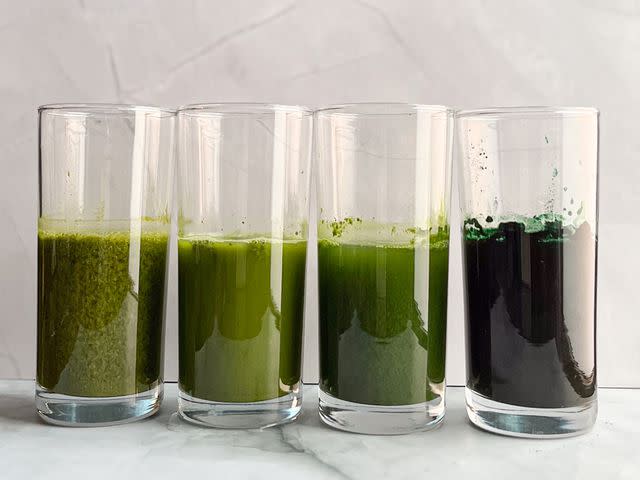
Serious Eats / Kelli Solomon
Powders dissolved in water, left to right: Pandan, matcha, spinach, spirulinaGreen #3: Spinach Powder
Next up was every kid’s favorite vegetable, spinach. Of course, spinach leaves (Spinacia oleracea) are a star ingredient in an endless number of recipes, but spinach powder is usually used as a nutritional supplement, especially in smoothies.
Spinach Powder Water Test: Once added to water, this solution was dark, hunter green, fully opaque, and homogenous. The Jade Green crayon was the closest color match I found in Crayola's green collection. The scent of the spinach powder/water mixture was super vegetal (which makes sense, right?), but it had a sweet, floral taste. Before this, I had only had spinach mixed with other fruit and vegetable juice, so I was surprised by its sweetness. It's not a complex flavor, but certainly an inoffensive one.
Spinach Powder Shamrock Shake Test: In the milkshake, it was almost as green as the food coloring and hardly detectable taste-wise.
Spinach Powder Frosting Test: This was the most vibrant, natural-looking green in the frosting and only had a slightly vegetal aftertaste.
Spinach Powder Conclusion: For color purposes, spinach powder is a great option. Would I use it to make bread or pasta? Definitely! The best news: This powder is sweet enough to add to your cookies and cakes, too.
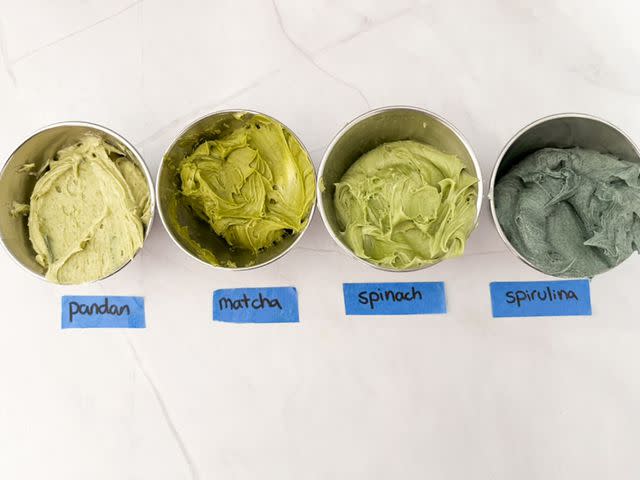
Serious Eats / Kelli Solomon
Green #4: Spirulina Powder
Spirulina (Arthrospira platensis) is a type of blue-green algae cultivated in alkaline lakes in tropical climates. Like spinach, spirulina is also typically used as a supplement in smoothies and juices. I've even seen it as an ingredient in cocktails for its vibrant color, which is close to Crayola’s Tropical Rainforest crayon.
Spirulina Powder Water Test: The water solution was vibrant and saturated. Spirulina is not purely green—the color comes from a combination of chlorophyll and phycocyanin's blue pigments. The vivid color was so alluring that I forgot that I was drinking algae, so I was shocked when my first taste hit me with a funky oceany aftertaste and a seaweedy smell that calls to mind the ponds it grows in. The solution was thicker than the others, so it coated my tongue and lingered in a way I did not enjoy.
Spirulina Powder Shamrock Shake Test: In the milkshake, it was a little more blue than green and tasted slightly too salty.
Spirulina Powder Frosting Test: In the frosting, the spirulina was even more blue and wasn't homogeneous, leaving dark blue specks. The ocean-forward flavortaste combined with the sugary frosting was unappetizing. The color from spirulina is vivid, but I'd use it sparingly since the aquatic taste might not be what you're looking for. Luckily, this color is hyperconcentrated, so a little goes a long way. Just a touch in a smoothie is all you need.
The Verde Verdict: The Best Plant-Based Green Food Coloring
In a St. Patty's Day showdown, spinach powder is the clear winner. When you think of shamrock green, this is it. Spinach also proved to be surprisingly versatile even in sweet applications thanks to its slightly sweet taste. However, don't count out pandan or matcha if you’re more focused on flavor than color; both have rich layers of flavor that work beautifully in sweet preparations and deserve to be part of your culinary rotation. Finally, spirulina's blue-green leans blue but provides the highest pigmentation and the most vivid color, but its oceanic qualities make it a less natural match in many recipes. Who knows—it could make for a fun, marine-looking mayo designed as a condiment for fried seafood.
Read the original article on Serious Eats.

